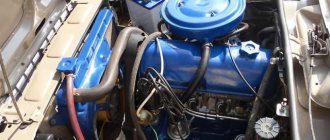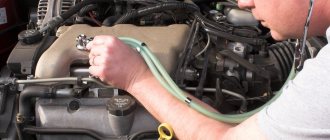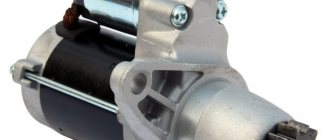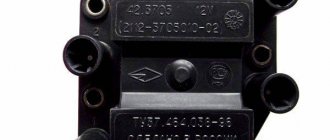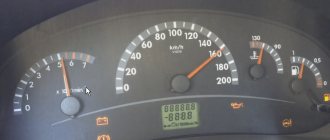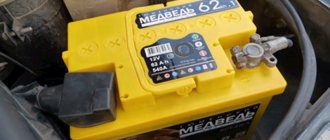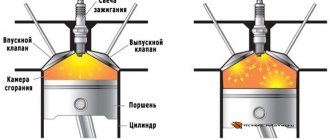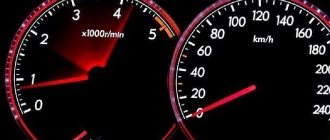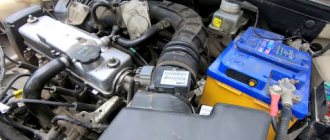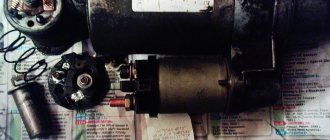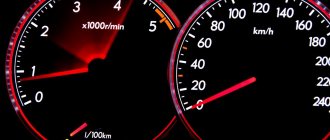The serial equipping of cars with computer systems that make it possible to quickly find faults began about three decades ago. The connection of such systems to special testers is carried out using the connectors located in them and is carried out only under service conditions by specialists. The car owner is notified of the presence of problems by the illuminated Check Engine light on the dashboard.
A similar warning system is used on modern car models - it is installed on almost all cars with injection engines, which are controlled by a microprocessor. Therefore, owners of such cars should have an idea of what to do if the check light is on and what the reasons for its inclusion may be.
How to diagnose it yourself?
You can purchase a portable and inexpensive ELM 327 scanner.
By spending about 1,000 rubles on a portable scanner, you can diagnose the engine management system yourself.
By spending about 1,000 rubles on a portable scanner, you can diagnose the engine management system yourself.
It plugs into the OBD-II connector. You need to install a program for communicating with the car on your smartphone (you can use one of the free ones, they also work). By connecting the scanner to a smartphone via Bluetooth or Wi-Fi, you can read errors recorded by the control unit.
Top 10 reasons for the “check” signal
For car owners, it is important what the “check” and error codes on the instrument panel mean, so the causes and methods of troubleshooting should be considered in detail. The check engine light can come on due to hundreds of faults. The list of common reasons why the check may light up or flash includes:
- Poor fuel quality . In Russia, refueling with low-quality fuel is considered the most common reason why the yellow icon of a faulty engine lights up.
- Damage to the lambda probe. (2 – 4) are installed on the exhaust gas emission system . If the lambda probe is faulty or clogged, the “check engine” light comes on.
- Poorly closed fuel tank cap. If the check engine light comes on when leaving a gas station and does not go out, check the gas tank cap.
- Clogged exhaust system catalyst. Fails due to natural resource depletion, clogging, or combustion of honeycombs.
- Malfunction of the mass air flow sensor . If the sensor breaks down, the check light comes on and the power of engine (internal combustion engine) drops.
- Clogged or worn spark plugs . The engine warning icon appears for any ignition failure. In addition to the indicator, failures in engine operation indicate faulty spark plugs.
- Oil level drop. At the same time, the check engine and oiler icons light up, which means that the internal combustion engine is operating in oil starvation mode.
- Clogged injectors . A burning check engine light is accompanied by sneezing and floating engine speed.
- Antifreeze leaks. The check engine icon and the cooling indicator light up, which means the internal combustion engine is overheating and the need to stop immediately.
- Electronic control (EDC) failures. Electronic engine error can be random or systemic. In the second case, computer diagnostics of the error code archive is required. You can fix a random failure yourself.
On the road, situations often arise when the check light is on and the message “ engine power limited ” is displayed. With this signal, the on-board computer responds to a number of breakdowns, which include:
- clogged filters (air, oil, fuel);
- failure of the crankshaft position sensor;
- short circuits, breaks in electrical cables;
- oxidation of contact pads, plugs, connectors;
- depressurization of the exhaust gas recirculation system;
- broken exhaust manifold gasket;
- knock sensor failure.
In these cases, to remove the check engine icon, the vehicle must be diagnosed and repaired at a qualified car service center.
Related material: How to independently diagnose a car using a laptop
What to do first
Do not immediately think that the red light directly indicates a problem in the engine system:
- The “Check Engine” may light up only when the engine is starting, and then go out immediately. This means that there is no reason for concern;
- It’s another matter if it continues to burn for a long time. This means that the motor is really not in order. Although there is a reason to work on the engine, there is no reason to despair, since mostly we are talking about minor malfunctions. Only in rare cases does the indicator warn of critical failures.
Causes of engine error
The fact that the check is flashing indicates a danger to the catalyst is understandable. The question “why?” Most likely, when you connect the scanner, you will receive the error p0300 multiple misfires. There may be several reasons for such omissions.
The most undesirable thing, in my opinion, is a burnt valve. When a valve burns out, the engine starts to rough up. Such tripling is usually permanent, since the cause is mechanical. Of course, such a motor pulls very poorly. It is highly not recommended to drive such a car, unless of course you want to change the oxygen sensor and catalytic converter in addition to the valve.
In addition to valves and spark plugs, there may be the following reasons:
Individual ignition coils may have a breakdown or an interturn short circuit. This can be determined using a non-contact probe and an oscilloscope program on a laptop. If you have an ignition module, you can check its operation by carefully removing the caps from the spark plugs.
Self-resetting errors
The basic way to reset errors is to disconnect the battery from the vehicle's on-board power supply for 20-40 seconds. The technique allows you to eliminate random failures in electronics, but it is impossible to clear non-volatile memory by stopping the power supply. If, when the power supply is restored, the check engine indicator does not go out, then the vehicle needs to be checked with a diagnostic tool.
Some cars provide for reading and deleting error codes using buttons on the instrument cluster (for example, resetting the daily mileage or switching operating modes of the on-board computer). A similar feature is provided in some cars from Nissan, Opel, Dodge and other manufacturers. After resetting the controller, the “check engine” icon should disappear, but if the engine malfunction reoccurs, the control indicator will turn on again (with the failure code recorded in the memory of the control unit).
For example, to reset the control unit memory in Dodge cars, you need to turn the ignition key three times from the “Look” position to the “On” position within 3 seconds. There is no need to start the engine; if the procedure is completed correctly, the display will display a line of dashes, and then the text Done will appear. When you re-ignite and start the power unit, there will be no error information.
On Nissan cars, to read the codes, you need to turn on the ignition and after 3 seconds, perform 5 consecutive presses on the accelerator pedal. Then a 7-second pause is given and another one is performed, this time all the way. The “check engine” lamp will begin to operate in a flashing mode, informing the owner about errors present in the memory of the control unit. To clear codes, you must keep the gas pedal pressed when the flashing indicator appears. After resetting the memory, the lamp emits 4 series of flashes of 10 signals each.
Is it possible to operate a car when the check light is on?
No worries
The Check Engine light, like other signals on the dashboard, light up and go out at the same time when you start the engine. This triggering is set to check the functionality of all indicators. It is advisable for the car owner to pay attention to this test when starting the engine in order to assess the performance of the light bulbs and the absence of errors.
When can you continue driving?
You can continue driving the car if the indicator lights up uninterruptedly, but no changes in the control and behavior of the car are noticed, the engine responds normally to pressing the gas pedal, and the other indicators on the dashboard do not light up. Despite the permission for further operation, in such a situation you can only move towards a car service in order to diagnose the system and identify faults.
When not to move
If the Check Engine light is flashing, and its operation is accompanied by malfunctions in the vehicle, then you should not move on. Ignoring a signal about a system malfunction can cause serious consequences that may lead to the need for repair work. In such a situation, it is best to call a specialist or a tow truck.
What to do if the check engine light comes on
In some cases, it is impossible to figure out what a lit emergency symbol means without analyzing the self-diagnosis codes embedded in the on-board computer. It is important for the driver to know why the check light is on and how urgently the power plant needs to be repaired. In case of some malfunctions, you can drive to the repair service yourself. In case of complex breakdowns, it is necessary to call a tow truck.
Table: Common Error Codes
Directories of self-diagnosis codes for foreign cars consist of multi-page descriptions. The main alphanumeric self-diagnosis code can be accompanied by a short description in English or Russian by the on-board computer. Since English-language terms are incomprehensible to many drivers, we present the main codes that accompany the illuminated check engine light, with a description in Russian.
| Codes | Description |
| P0100 | Failure of the air flow sensor (or circuit) |
| P0105, P0106 | Air pressure sensor signal abnormalities (may be associated with an open gas tank cap) |
| P0125 | Cooling faults |
| P0130 – P0140 | Incorrect signals, reading failures, lambda probe breaks |
| P0195, P0199 | Failures, signal violations of the oil temperature sensor |
| P0200 | Injector control circuit malfunctions |
| P0201 – P0212 | Defects in injectors by cylinder |
| P0230 – P0233 | Violations of the primary and secondary circuits of the fuel pump |
| P0300 | Misfires |
| P0301 – P0312 | Misfire (by cylinder) |
| P0321 – P0323 | Violations, omissions of ignition distribution signals |
| P0350 – P0362 | Ignition coil malfunctions |
| P0400 – P0402 | The exhaust gas recirculation system does not work |
| P0420 – P0434 | Catalyst malfunctions |
| P0561 | On-board voltage instability |
| P0600 – P0606 | Electronic control unit module errors |
| P1604 | Engine starting system failures |
| P1398 | Crankshaft position sensor failure |
| P1120 – P1125 | Violations of signals from the throttle valve |
| P1605 – P1620 | Flash Memory Failures |
For budget foreign cars, simultaneously with the check engine light coming on, the computer can display general error descriptions , such as “power is limited”, “maintenance is due”. In such situations, it is difficult to analyze the exact cause of the signal. The best solution would be to visit a car service center for a full computer diagnostic of the internal combustion engine.
How to get to a service station if the Check Engine light is on
In practice, if the check is flashing, this is due to a serious malfunction. It is impossible to continue driving with malfunctions of the crankshaft sensor, electrical wiring, oil starvation of the cylinders, a burning smell, floating speed or vibrations of the internal combustion engine.
Driving with clogged injectors ; operation with incorrect injection leads to the destruction of pistons, oil pans, and piston rings. In such cases, it is necessary to call a tow truck.
In what cases can you get to the service station yourself?
Experienced drivers and auto mechanics believe that you can drive to a service station under your own power in the following cases:
- after refueling with low-quality fuel;
- in case of breakdown of the mass air flow sensor;
- with a slight drop in power;
- when the message “Maintenance is due” appears.
In any case, driving with the check engine light on requires constant monitoring of the coolant temperature and oil level.
You need to go to the repair service at low speed. Be sure to ensure that the engine speed does not exceed 3000. It is recommended to drive smoothly, without sudden acceleration or braking. To facilitate the operation of electronics, you can turn off the radio (or media system) and turn off the air conditioning.
Replacing spark plugs and high-voltage wires
Spark plugs in a car are the main parts; they are designed to ignite the fuel mixture. With faulty spark plugs, the spark is not supplied correctly to ignite the gasoline mixture. With faulty spark plugs, it often happens that there is no spark or the timing of the supply of this spark is incorrect, and this affects the incorrect operation of the engine. If the spark plugs are not working correctly, you may feel slight jolts when accelerating the car, especially when starting from a standstill.
What are the reasons for the failure of spark plugs: -Most spark plugs in cars produced before 1996 must be changed every 25,000 - 30,000 thousand kilometers. In newer cars, these spark plugs last for more than 150,000 thousand km. But, nevertheless, these periods of planned replacement of spark plugs can be reduced due to various factors that are naturally associated with both fuel quality and driving style.
What needs to be done: -If your spark plugs have not been changed for a long time or you feel dips in the engine’s operation that are specifically related to the ignition, then you must immediately replace them with new ones without delay. Do not try to save money by untimely replacement of spark plugs, since the cost of the spark plugs itself is not as expensive as the work itself to replace them. By replacing old spark plugs with new ones, you will improve engine performance and reduce vehicle fuel consumption. Changing the spark plugs in your car yourself is quite easy. Basically, they are all easily accessible under the hood of the car. You only need a regular spark plug wrench to remove the spark plugs from the engine. It is also advisable to monitor the condition of high-voltage wires, since over time they can become unusable and allow electricity to pass through, which is transferred to the spark plugs, which can reduce the strength of the spark. Remember that regular replacement of spark plugs in accordance with the maintenance schedule for your car protects your exhaust catalyst from breakdowns, and at the same time improves the performance of the engine itself!
This article of ours was originally published in 2013, and was further updated with new information on 02/17/2020.
How to remove check engine
Auto mechanics fix the engine error and “clear” the check in a few minutes. On the road, it is not always possible to remove the check engine icon.
If you refueled with low-quality fuel
If immediately after refueling the check light comes on, the engine noise changes, or the power drops, an experienced driver can immediately determine the cause. The on-board computer considers a low octane number of gasoline or clogging of diesel fuel with impurities or paraffin to be an engine error. The computer indicator signal is not associated with the breakdown. The use of low-quality fuel leads to a drop in power and acceleration dynamics deteriorate.
With a full tank, you won’t be able to quickly remove the “check” on the instrument panel; you need to wait until 40-50% of the fuel . If the icon appears after filling 10 -20 liters of “ninety-five” gasoline, you need to fill the same amount of A-98 or “super” . The check engine light will go out after 5 to 10 minutes of driving.
Lambda probe failure
There are no effective methods for checking the serviceability of the meter for the amount of unburned oxygen in the exhaust gases. In garage conditions, you can check the performance of the lambda probe with a multimeter, clean the housing, ceramic rod, and platinum contacts of the probe with phosphoric acid.
When the computer indicator light comes on, you can continue driving at low speed , since the motor can completely block at any time.
If the catalyst is clogged
If there is a malfunction in the exhaust system , the check light flashes, the catalyst icon lights up, and the color of the exhaust smoke changes. While driving, a clogged catalyst manifests itself by reducing the power of the internal combustion engine. In the garage, the catalyst can be checked by installing a pressure gauge in place of the lambda probe.
Comparison of measurements of exhaust pressure gauge readings at 3000, 5000 rpm will clearly show the degree of contamination and deformation of the honeycombs. Catalysts cannot be repaired; replacing them at a service station is an expensive repair operation.
Soot on candles
Malfunctions in the ignition system occur due to carbon deposits, wear of spark plugs, short circuits in electrical wiring, and contamination of contact pads. An experienced driver can easily determine the cause of a breakdown (carbon deposits, wear of spark plugs) by the changed color of the porcelain cylinder and deformation of the electrodes. If you carry spare parts and a spark plug wrench with you, replacing spark plugs is not difficult.
After replacing the spark plugs, when starting the internal combustion engine, the check engine symbol does not light up, which means that the functionality of the ignition system has been restored.
Oil level drop
It manifests itself in the appearance of an indicator signal a few minutes after starting the engine; in expensive foreign cars it is accompanied by an overheating icon. When the symbol appears, you need to stop the car and check the engine oil level with a dipstick. When inspecting the power plant, they look for traces of lubricant leaks on the cylinder head, from under the oil seals, and gaskets.
After adding engine oil and warming up the engine, the check engine indicator does not light up , which means you can continue driving without a speed limit.
Antifreeze leaks
“low coolant level” appears and the check light is on, the driver needs to check the antifreeze level in the expansion tank and try to detect leaks. But often the engine icon lights up for other reasons.
The indicator can also work if coolant gets into the cylinders or when different brands of antifreeze are mixed. The sensors react to the formation of a foam emulsion and the use of antifreeze diluted with water. If you find no leaks, add antifreeze to the required level and the indicator does not go off, the reason is a breakdown of the coolant level sensor.
It is impossible to replace the sensor on the road. To eliminate the malfunction or replace damaged cooling pipes, you will need to contact a car service.
Damage to the mass air flow sensor
mass air flow sensor is responsible for the correct proportions of air saturation of the fuel-air mixture, which is injected into the cylinders of the power unit. The breakdown is not critical , but it leads to increased fuel consumption and slow acceleration of the vehicle. Repair is complicated by the high cost of the mass air flow sensor.
two ways to check the performance of the DRMV .
- In hot-wire sensors, visual inspection reveals broken platinum threads.
- DRMVs of other types are checked by disconnecting the plug. If the speed increases, the breakdown of the mass flow sensor is obvious.
To restore normal air saturation of the fuel rail, it is necessary to replace the mass flow sensor at a service station.
Clogged injectors
In expensive foreign cars, clogged injectors on each cylinder can be tracked using the personal self-diagnosis code of the on-board computer. Track repairs and cleaning of injectors in a garage are impossible, as they require complex disassembly and assembly operations of the fuel rail.
At car services, injectors are cleaned on special ultrasonic cleaning stands or completely replaced. You can continue driving with one or two clogged injectors at low speeds.
ECU failures
The only way to independently reset the indicator signal in the event of ECU failures is to turn off the vehicle's power supply. The signal on the instrument panel lights up when minor error codes or electronic “glitches” accumulate in the on-board computer. A random engine error can be removed by resetting the negative terminal of the battery for 20 - 30 seconds .
When the electronic control unit is rebooted, minor archived errors are reset. Resetting can be checked by restoring the computer clock to factory settings. System errors cannot be eliminated on their own; to restore the ECU's functionality, it may be necessary to replace electronic boards or re-flash the software.
It is not recommended yourself . In a garage or parking lot, it is difficult to perform such operations as replacing the crankshaft position sensor, damper, or exhaust manifold gasket.
Complex work includes instrumental testing of electrical circuits, searching for short circuits in electrical wiring, and repairing worn-out, damaged electrical equipment.

